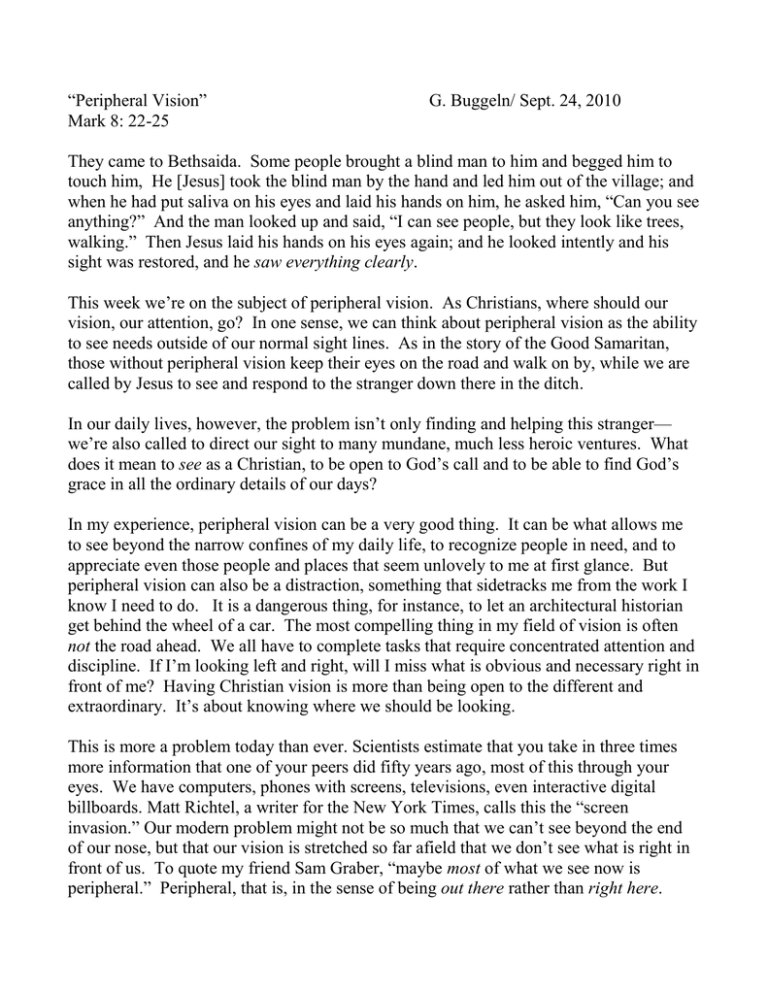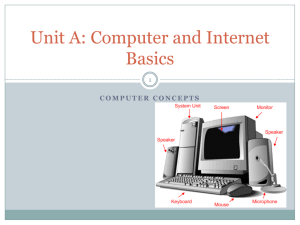“Peripheral Vision” G. Buggeln/ Sept. 24, 2010 Mark 8: 22-25
advertisement

“Peripheral Vision” Mark 8: 22-25 G. Buggeln/ Sept. 24, 2010 They came to Bethsaida. Some people brought a blind man to him and begged him to touch him, He [Jesus] took the blind man by the hand and led him out of the village; and when he had put saliva on his eyes and laid his hands on him, he asked him, “Can you see anything?” And the man looked up and said, “I can see people, but they look like trees, walking.” Then Jesus laid his hands on his eyes again; and he looked intently and his sight was restored, and he saw everything clearly. This week we’re on the subject of peripheral vision. As Christians, where should our vision, our attention, go? In one sense, we can think about peripheral vision as the ability to see needs outside of our normal sight lines. As in the story of the Good Samaritan, those without peripheral vision keep their eyes on the road and walk on by, while we are called by Jesus to see and respond to the stranger down there in the ditch. In our daily lives, however, the problem isn’t only finding and helping this stranger— we’re also called to direct our sight to many mundane, much less heroic ventures. What does it mean to see as a Christian, to be open to God’s call and to be able to find God’s grace in all the ordinary details of our days? In my experience, peripheral vision can be a very good thing. It can be what allows me to see beyond the narrow confines of my daily life, to recognize people in need, and to appreciate even those people and places that seem unlovely to me at first glance. But peripheral vision can also be a distraction, something that sidetracks me from the work I know I need to do. It is a dangerous thing, for instance, to let an architectural historian get behind the wheel of a car. The most compelling thing in my field of vision is often not the road ahead. We all have to complete tasks that require concentrated attention and discipline. If I’m looking left and right, will I miss what is obvious and necessary right in front of me? Having Christian vision is more than being open to the different and extraordinary. It’s about knowing where we should be looking. This is more a problem today than ever. Scientists estimate that you take in three times more information that one of your peers did fifty years ago, most of this through your eyes. We have computers, phones with screens, televisions, even interactive digital billboards. Matt Richtel, a writer for the New York Times, calls this the “screen invasion.” Our modern problem might not be so much that we can’t see beyond the end of our nose, but that our vision is stretched so far afield that we don’t see what is right in front of us. To quote my friend Sam Graber, “maybe most of what we see now is peripheral.” Peripheral, that is, in the sense of being out there rather than right here. My 13 year old son, like most kids his age, is adept at media and spends a lot of time on his gadgets. But I remember one day when he came home from his friend’s house, looking sad. What’s up? I asked. I don’t see the point, he complained, of being over at my friend’s house, sitting next to him on the couch, when he is on Facebook. We all know what it feels like to be ignored, and to ignore. I’ll admit I’ve looked at my cell phone while checking out at Target. And how many times have I been viewing email when I knew I should have been giving my attention to something or someone else? Brain scientists tell us we are wired for novelty. This is why it is so hard to continue a conversation with the person next to you when your cell phone rings. Our natural inclination is towards distraction, and our culture promotes it. This can’t help but affect the relationships we have with each other This summer I worked with a group of students in North Carolina for a month of intensive study in a museum community. One young woman, towards the end of the program, expressed to me that she had just been really happy during these weeks. The reason why, as she understood it, was that she had been able to be fully present in this place. She turned off a lot of outside media and centered on our group and our project. A college campus presents this same opportunity, but how hard is it to be fully present, to see and respond to those right in front of us, to discipline our vision in the direction of what matters? In this passage in Mark’s gospel, Jesus heals the blind man in stages. First the man sees only dim shapes, people that look like trees. Then Jesus again touches his eyes and the man sees clearly. Mark’s Jesus is generally in a hurry, kind of short with people, but here he seems intense but patient, waiting for the healing process to run its course. As I’ve been considering how our vision and focus constantly becomes distracted, foggy, too peripheral, the lesson for me in this passage is that we need to keep coming back to Jesus to clear things up. And it was the people in the formerly blind man’s line of sight who became particularly clear. They didn’t look like trees anymore, but like living, breathing human beings. I’ve noticed that I see differently when I walk out of chapel. I’m looking for different things, and I see what I see in a new light. If I spend time refocusing here, in the presence of God and this Christian community, my vision improves. May God bless us with attentive vision today. Amen.



